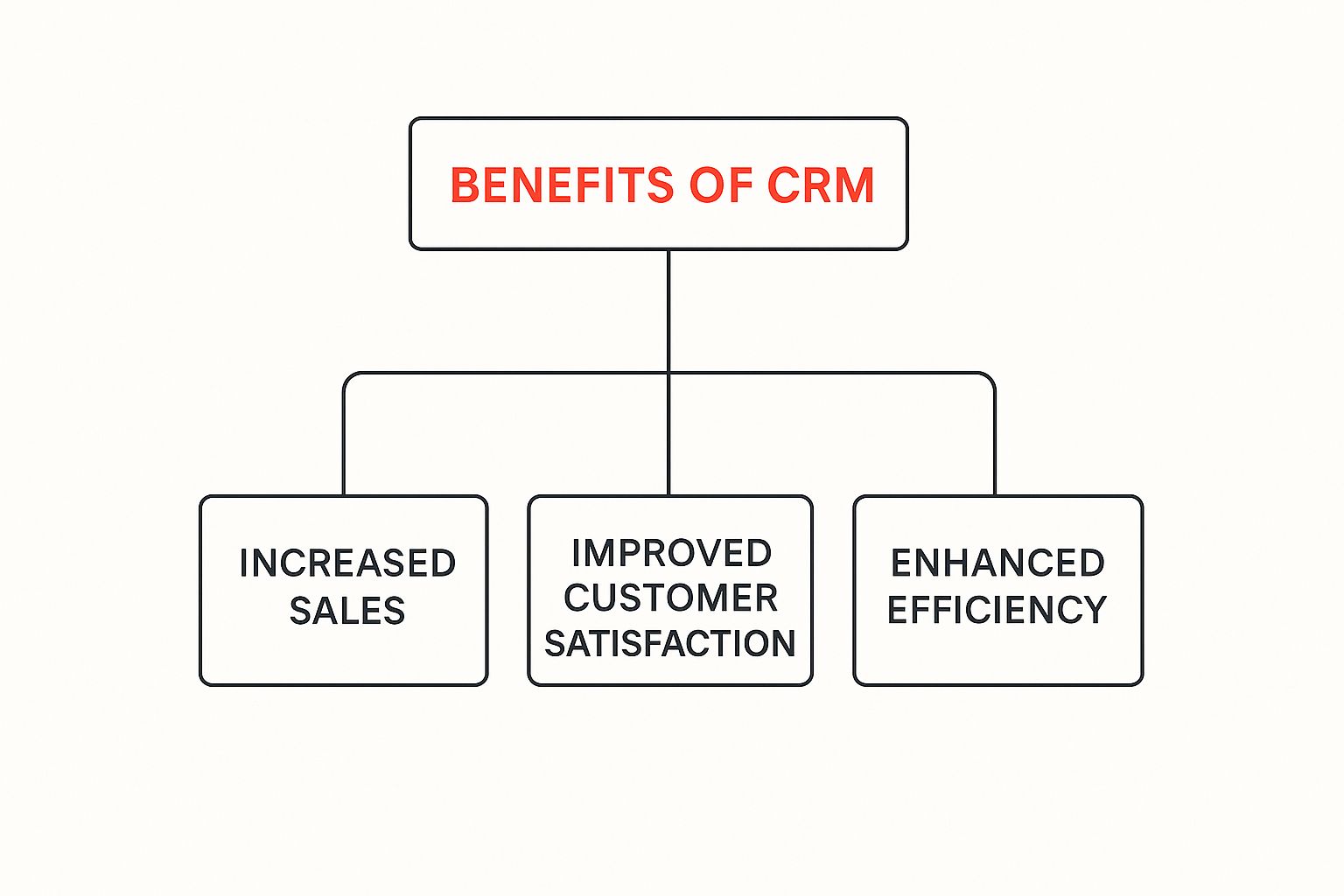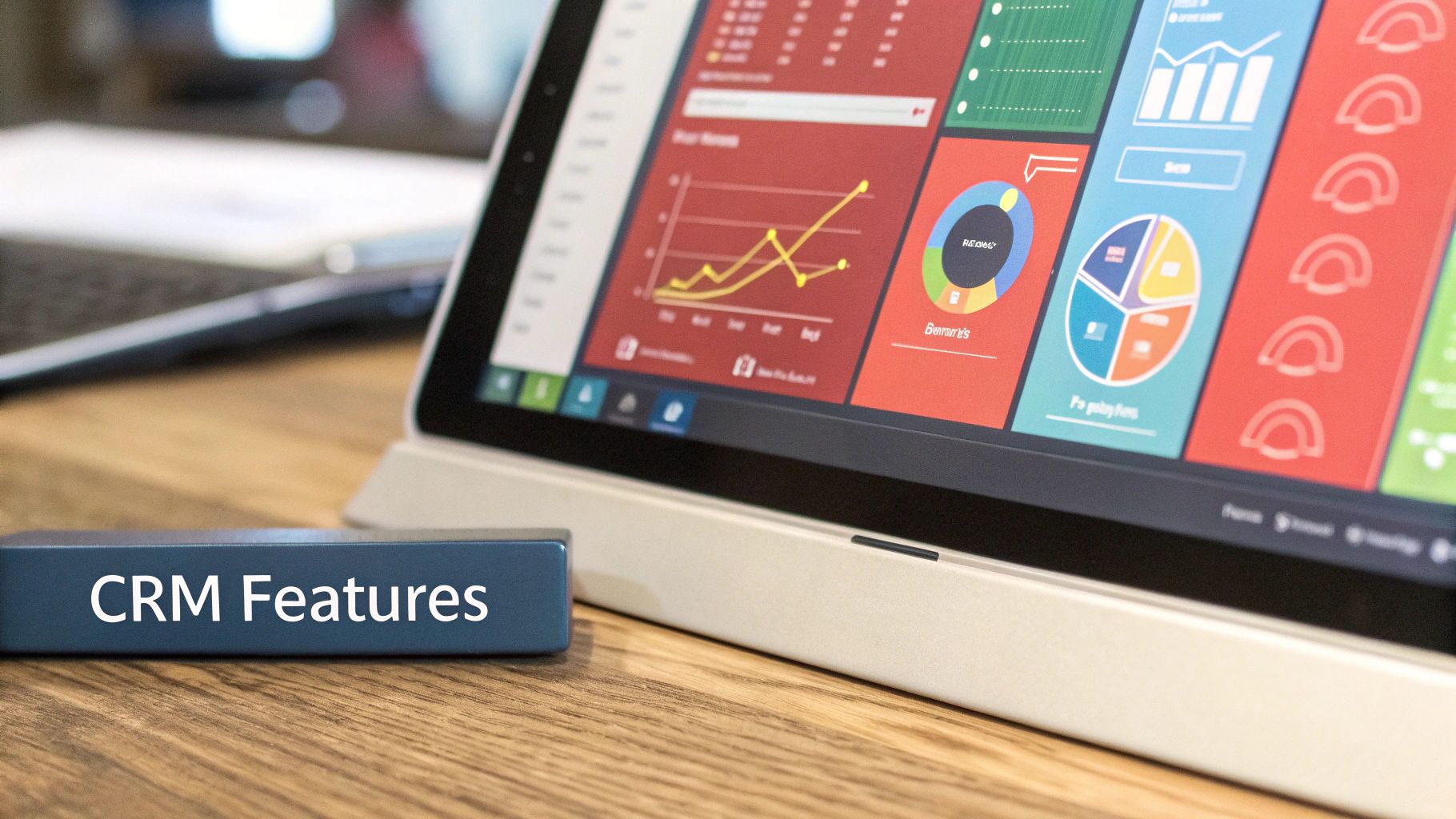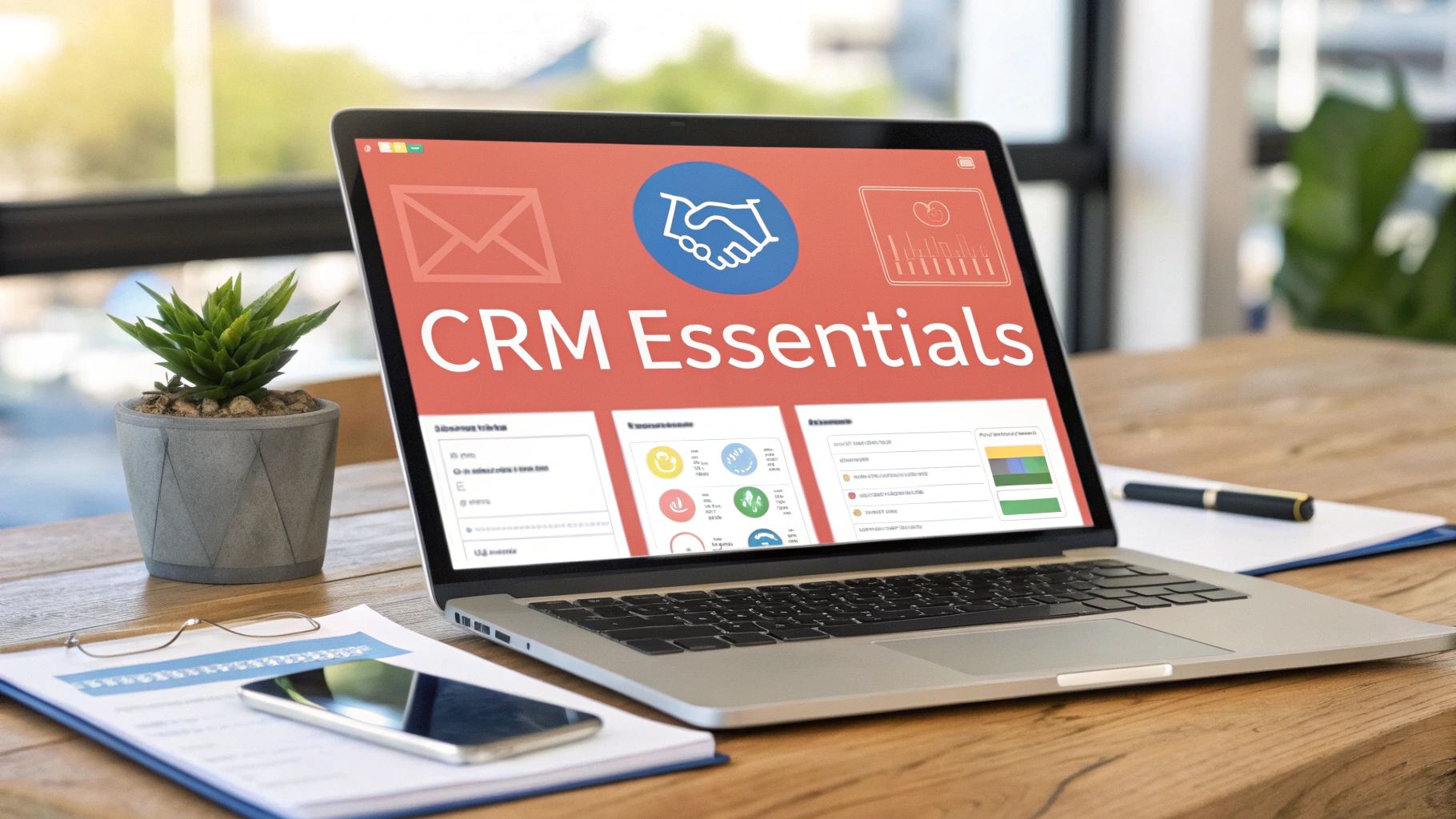So, what exactly is client relationship management?
At its core, it's the mix of strategies and tech you use to build and maintain solid, positive connections with your customers. But for an agency, it's so much more than a fancy contact list. It’s the entire operational playbook for managing every single client interaction—from the first pitch to the final invoice and everything in between.
Defining Client Relationship Management in an Agency Context

Let's ditch the textbook definition for a second. In a modern agency, client relationship management isn't just a piece of software. It’s a philosophy. Think of it as the central nervous system that connects your team, your projects, and all your client communication into one cohesive, living system.
This whole approach has come a long way from the days of a simple Rolodex. Today, it’s about creating a single source of truth for every client account, tracking every single touchpoint—from the initial discovery call and proposal to ongoing project updates and scope changes.
How to Evolve from Service Provider to Strategic Partner
This is the mindset that separates a reactive service provider from a proactive strategic partner. When you have a crystal-clear, organized view of a client's history and all your interactions, you can stop just fulfilling requests and start anticipating their needs. This is how your agency turns one-off projects into profitable, long-term partnerships.
A proactive approach means you can spot potential issues before they blow up, identify natural upsell opportunities, and deliver consistent, predictable value. This is the bedrock of client retention and growth for any agency.
Making this strategic shift isn't just a "nice-to-have" anymore; it's essential for any competitive agency. The numbers back it up. The customer relationship management (CRM) market is valued at a staggering $101.4 billion in 2024 and is expected to rocket to $262.74 billion by 2032. This explosion is driven by businesses—agencies included—realizing they need these systems to boost sales, keep clients happy, and create more personal engagement. You can explore more about these CRM trends and see the impact for yourself.
Breaking Down Core CRM Functions for Your Agency
So, what does this actually look like day-to-day in an agency? It’s about way more than just storing phone numbers. To get practical, we've broken down the core functions of agency client relationship management into a simple table.
This table moves past generic definitions to show you what these functions really mean for your agency's operations and bottom line.
By mastering these areas, your agency builds a resilient framework that not only keeps current clients happy but also attracts new ones through a powerful reputation for being a true partner.
The Three Pillars of a Winning Agency CRM Strategy
A powerful client relationship management approach doesn’t just materialize out of thin air; it has to be built with intention. For any agency, a truly successful CRM strategy is propped up by a few core pillars that completely change how you handle accounts, talk to clients, and ultimately, grow your business.
Getting these components right is what separates a chaotic, reactive agency from a focused, proactive partner. A winning strategy is about so much more than just storing contact info. It’s about creating a living, breathing ecosystem for client success. The goal isn't to add more work to your team's plate—it's to make the right work easier and more impactful for everyone, from account managers to project leads.
This is where you lay the groundwork to turn raw client data into your agency's most valuable asset.
Pillar 1: Build a Single Source of Truth (SSoT) for Client Data
The first and most fundamental pillar is establishing a single source of truth (SSoT). Just picture it: a world where every single client email, call note, meeting takeaway, and project update lives in one central, easy-to-access hub. This pillar is all about closing those dangerous information gaps that lead to costly mistakes and unhappy clients.
Think about it. Your lead account manager is on a well-deserved vacation when a client calls with an urgent request. Can anyone on your team jump in with the full picture? An SSoT makes that a reality. It puts an end to the frantic "who talked to them last?" scramble and ensures every client conversation is consistent and informed, no matter who is on the call.
An SSoT isn't just a database; it’s your agency's collective memory. It prevents critical details from getting lost in siloed inboxes or forgotten after a call, creating a unified view of the entire client journey.
This centralized hub becomes the bedrock for truly understanding your clients and serving them effectively.
Pillar 2: Nurture a Proactive Client Partnership
Once all your data is in one place, you can start building the second pillar: shifting from a reactive service provider to a proactive strategic partner. Instead of just sitting back and waiting for client requests, you can use your data to get ahead of their needs and actively guide their strategy.
This is where the real magic of client relationship management shines for agencies. By digging into communication patterns and project history, you can start to:
- Spot Upsell Opportunities: Notice a client is repeatedly asking about a service you offer? That's a warm lead for an upsell, flagged automatically by your system.
- Address Issues Early: See a dip in communication or a note about a missed deadline? You can step in to address potential dissatisfaction before it snowballs into a major problem.
- Provide Strategic Guidance: A complete view of their business challenges allows you to offer insights that go beyond your current scope, solidifying your role as an indispensable partner.
This shift changes the entire dynamic of your client relationships, building loyalty that goes far beyond a single project's deliverables.
For more hands-on advice, you can discover a wealth of actionable strategies in our guide covering essential client relationship management tips for modern agencies.
Pillar 3: Generate Actionable Performance Insights
The final pillar is all about using your CRM for performance insight. This means turning all that collected data into smarter business decisions. A well-oiled CRM strategy gives you the analytics you need to understand your agency's health with complete clarity.
This is where you connect relationship management directly to your bottom line. You can finally answer critical questions like:
- Which clients are actually our most profitable?
- Which of our service lines generate the most revenue?
- Are we at risk of churn with any key accounts?
- Can we accurately forecast revenue for the next quarter?
This infographic breaks down the primary benefits that sprout from a strong CRM foundation.

As you can see, these pillars directly support increased sales, improved satisfaction, and enhanced efficiency—the core outcomes every agency is shooting for. By building your strategy on these three pillars, you create a resilient, data-driven operation that's ready for sustainable growth.
How Great Client Management Becomes Your Agency's Superpower

Let's be honest. Getting great at client management does more than just keep people happy. It fundamentally transforms your agency, making it more resilient, efficient, and—most importantly—profitable. It's the real difference between constantly scrambling for new leads and building a solid base of loyal clients who practically sell for you.
This isn't about making small tweaks here and there. It's about developing a genuine competitive edge.
When you weave a strong client management strategy into the very fabric of your operations, you’ll see real, tangible results. You’ll build unbreakable loyalty, bring order to chaotic workflows, and unlock a new level of teamwork. This is how you stop treating client management as just another task and start wielding it as your agency's true superpower.
Achieve Unbreakable Client Loyalty and Higher Retention Rates
The first and most immediate payoff of a solid client management system is a huge jump in client retention. Happy clients stick around. And in the agency world, loyal clients are your lifeblood. It costs a whole lot more to land a new client than to keep a current one, making loyalty a direct line to better profitability.
Put yourself in your client's shoes for a second. When they feel like you get them—when anyone on your team can jump into a conversation and already know their history, goals, and past headaches—they feel truly valued. That deep sense of partnership is something a competitor just can’t replicate.
A strong client relationship management system builds a defensive moat around your key accounts. It turns a transactional service into a strategic partnership, making your agency indispensable and churn a rarity.
This loyalty isn't just about stopping clients from walking away. It encourages them to invest more with you over time, boosting their lifetime value and creating a predictable stream of revenue you can actually build upon.
Foster Seamless Collaboration Across Agency Teams
One of the biggest hidden drags on any agency's performance is the dreaded "information silo." You know what I'm talking about—that critical piece of client knowledge trapped in one person's inbox, a random spreadsheet, or worse, just in their head. The moment that account manager calls in sick or goes on a well-deserved vacation, projects grind to a halt and clients get antsy.
A centralized approach to client relationship management shatters these silos. It creates a single source of truth, ensuring every single team member—from sales to project management to creative—is looking at the same up-to-date client information. This unified view immediately leads to:
- Smoother Handoffs: When a new PM takes over an account, they have the full context from day one. No more awkward "getting up to speed" calls.
- Less Internal Friction: Your team spends less time hunting for information and more time doing the brilliant work clients pay for.
- A Consistent Client Experience: The client gets the same high-caliber service, no matter who they happen to be talking to that day.
Breaking down these walls isn't just an efficiency play; it’s about creating a more cohesive, less stressful environment for your entire team.
Boost Profitability with Smarter Resource Allocation
Great client management is also a seriously powerful tool for financial growth. When you track all your interactions and project outcomes in one place, you can finally get a clear answer to the most important question: "Who are our best clients?" A unified client view helps you pinpoint which accounts are not just the most profitable, but also the best fit for your agency’s unique talents.
This insight lets you allocate your most precious resource—your team’s time—with surgical precision. You can double down on your high-value relationships and strategically nurture accounts with the biggest growth potential. This data-driven approach pulls your agency out of the world of guesswork and into one of informed financial strategy.
The global push for these systems is undeniable; CRM software revenues hit an incredible $48.7 billion in 2021 and are projected to rocket past $114.4 billion by 2027. You can discover more about the explosive growth of CRM statistics and see exactly why top-tier agencies are investing so heavily.
By focusing your energy where it delivers the biggest punch, you not only improve your bottom line but also create happier clients in the process. For a closer look at this, check out our guide on how to improve client satisfaction and turn those happy clients into powerful, long-term partners.
Choosing the Right Client Management Tools for Your Agency
The right technology can be a massive amplifier for your client relationships, but let's be honest—staring at the endless sea of software options is overwhelming. Picking the perfect tool isn't about finding the one with the flashiest features. It's about finding the software that genuinely clicks with your agency's unique workflow, size, and how you approach client service.
This decision is where the rubber meets the road. It’s the critical step that turns all the great ideas about client relationship management into a real, working system. The right platform takes you from good intentions to a repeatable process for delivering standout client experiences. It truly becomes the digital backbone of your entire client-first strategy.
And the market for these tools? It's huge and growing at a blistering pace. The global CRM market was valued at $73.4 billion in 2024 and is on track to hit $163.16 billion by 2030. That explosion is fueled by businesses, especially service-based ones like agencies, needing to automate engagement and get their digital operations in order. You can find more details on these CRM market trends on grandviewresearch.com.
Step 1: Define Your Agency's Core Needs
Before you even think about watching a product demo, you need to do a little internal audit. Where are the biggest friction points in your current client management process? While a key part of this is integrating lead automation CRM systems to clean up your sales pipeline, your agency's needs run much deeper.
Sit down with your team and create a checklist of non-negotiable features. Think about your day-to-day work and what would make the biggest difference.
- Project Management Integration: Does it play nicely with the tools your team lives in every day, like Asana, Monday, or ClickUp? A disconnected system just creates more headaches.
- Client-Facing Portals: Do you need a slick, professional portal where clients can log in to check project status, approve deliverables, or pull reports? This is a huge win for transparency and trust.
- Insightful Reporting Dashboards: Can you easily see crucial agency metrics like client profitability, team utilization, and overall account health? The goal is actionable insights, not just a wall of data.
- Scalability: Will this tool grow alongside you? A platform that’s perfect for a five-person shop might crumble under the weight of a 25-person agency.
By defining your must-haves from the get-go, you can cut through the noise and zero in on platforms that will actually help your agency thrive.
Now, let's look at the different categories of tools out there. Each is built for a slightly different purpose, and understanding the landscape will help you make a smarter choice.
Step 2: Compare CRM Tool Categories for Agencies
Choosing the right type of CRM is just as important as choosing the specific brand. Here's a breakdown to help you understand which category aligns best with your agency's model.
This table should give you a starting point. Most successful agencies end up using a combination—like a sales-focused CRM paired with a specialized AI assistant—to build their ideal tech stack.
Step 3: Enhance Your CRM with AI Meeting Assistants
While a central CRM is your command center, a new category of specialized tools is emerging that can supercharge your client intelligence. This is where AI meeting assistants like Scribbl come into the picture. These tools plug right into your agency's workflow and solve a very specific, high-value problem: unlocking the crucial insights buried in your client conversations.
An AI meeting assistant automatically records, transcribes, and summarizes every single client call. It pinpoints key topics, pulls out action items, and can even pick up on client sentiment—all without anyone needing to furiously type notes.
For an agency, this is a total game-changer.
Instead of relying on a project manager's scribbled notes, the entire conversation becomes a searchable, shareable asset. You can instantly draft follow-up emails, build proposals based on what was discussed, and sync action items directly into your CRM or project management tool.
This screenshot shows how a tool like Scribbl can organize meeting information, making it instantly accessible and actionable for your team.
This clean, organized view ensures that no critical client request or piece of feedback ever gets lost in the shuffle. It bridges the gap between the conversation and the execution.
What this means for an agency is that insights from a sales call can automatically inform the project kickoff. Feedback from a weekly check-in can flag potential scope creep or even reveal a new upsell opportunity for an account manager. It enriches your "single source of truth" with the most valuable data you have: the client's own words.
By pairing a solid CRM with an intelligent meeting assistant, you create a truly comprehensive system for managing the entire client relationship.
How to Build an Agency CRM Culture That Actually Sticks

Here's a hard truth most agency leaders learn the expensive way: buying the CRM software is the easy part. The real battle, where most of these initiatives fall flat, is getting your team to actually use it. A powerful CRM can quickly turn into a pricey, digital ghost town if your team doesn't embrace it.
The secret isn't more top-down commands. True success comes when you shift the conversation from technology to people. You have to build a culture where the CRM is seen as an essential tool that makes everyone's job easier, not just a way for managers to keep score. The mission is to kill the dreaded "empty CRM" syndrome before it even starts.
This isn't an accident. It's a deliberate strategy to weave a client-first mindset into the DNA of your agency.
Shift the CRM from a "Management Tool" to a "Team Asset"
The single biggest mistake you can make is framing the CRM as a "management tool." As soon as your team thinks it’s just another way for leadership to peer over their shoulder, they’ll resist. It's human nature. The key to getting everyone on board is to show them exactly how it makes their own lives better.
You have to answer the "What's in it for me?" question for every single person on your team.
- For Account Managers: Show them how it ends the frantic search for old emails, giving them instant context right before a client call.
- For Project Managers: Highlight how it links client conversations directly to project tasks, which means fewer missed deadlines and less scope creep.
- For Sales Reps: Demonstrate how it automates follow-ups and serves up a rich history of every client interaction, leading to smarter, more effective conversations.
When the CRM feels less like a chore and more like a personal assistant, adoption skyrockets. It becomes a natural part of their daily rhythm, which is the real goal of client relationship management.
Establish Simple and Clear Data Standards for Your Team
An empty CRM is a waste of money, but a CRM filled with messy, unreliable data is actively harmful. Bad information poisons the well, eroding trust and making the whole system worthless. To prevent this, you need to set up dead-simple, non-negotiable data standards from day one.
Complexity is your enemy here. Forget about creating a hundred mandatory fields. Focus only on the essentials that deliver real-world value.
Your mantra for data entry should be: "Make it easy to do right and hard to do wrong." Zero in on a handful of critical data points—like logging all client calls, updating contact info, and noting key decisions—that everyone must capture, every time.
This disciplined approach ensures your "single source of truth" is, well, true. When your team trusts the information they see, they'll use the system. When they don't, they'll abandon it. It really is that simple. Clean data is also the bedrock of effective client communication best practices, ensuring everyone is on the same page.
Create a Frictionless and Integrated Agency Workflow
A CRM can't live on an island. For it to become a true daily habit, it has to be woven into the fabric of the tools your team already uses every single day. The goal is a frictionless workflow where information flows automatically, cutting down on manual entry and connecting the dots between conversations and actions.
Think of your agency's tech stack. The CRM should be the central hub that speaks to everything else.
- Integrate with Slack: Pipe notifications for new leads or important client updates directly into the relevant channels.
- Connect to Project Management Tools: Automatically create tasks in Asana or Monday.com from action items you identified in a client call.
- Link with Billing Software: Sync client data to make sure invoices are accurate and hit the right inbox without anyone having to type the same info twice.
By making the CRM a silent, helpful partner in your team's existing flow, you remove the friction that kills adoption. It transforms your platform from just another login to remember into the powerful, automated engine that runs your entire client operation.
Your Top Agency CRM Questions, Answered
Jumping into the world of client relationship management always brings up questions, especially when you're a busy agency leader trying to make the right call. We get it.
Below, we've tackled some of the most common queries we hear from agencies just like yours. No fluff, just straight-up, practical advice to help you move forward.
How Can a Small Agency Start with CRM on a Tight Budget?
You definitely don't need a massive enterprise-level budget to get started. Far from it. Many of the best CRM platforms offer "freemium" or very affordable entry-level plans that are perfect for smaller agencies.
The real key is to start with the core functions that will give you the biggest bang for your buck, right now.
Focus on mastering these two areas first:
- Centralized Contact Management: This is step one. Get every client's contact info, key stakeholders, and basic interaction history out of spreadsheets and into one central, accessible hub.
- Communication Tracking: Simply logging every important email and call note creates an invaluable history for each account. You'll wonder how you ever lived without it.
Start small and pick a tool you know can grow with you. As your agency and revenue expand, you can unlock more advanced features without the headache of switching platforms and migrating all your data.
What Are the Biggest Mistakes Agencies Make with Their CRM?
The single most damaging pitfall is treating the CRM like a "Big Brother" tool for management to spy on the team. This approach is a one-way ticket to resentment and guarantees nobody will use it. If your team sees it as a chore instead of a helpful tool, they won't put good data in, making the whole system worthless.
Another huge mistake is failing to weave the CRM into your team's actual, day-to-day workflow. If it feels like a separate, clunky task that requires another login and more clicks, it’s going to be ignored. A great CRM should plug right into your project management and communication tools, acting like a seamless assistant, not another burden.
How Can an Agency Measure the ROI of Its CRM Efforts?
Measuring the return on your CRM investment goes way beyond just counting new sales. For agencies, the real value shows up in metrics that reflect the health and loyalty of your client base. A good CRM will make tracking these KPIs a breeze, proving how stronger relationships directly fatten your bottom line.
You'll want to keep a close eye on metrics like:
- Client Lifetime Value (CLV): Are clients sticking around longer? Are they increasing their spend over time?
- Churn Rate: How good are you at keeping clients from walking out the door? This is a direct measure of satisfaction.
- Net Promoter Score (NPS): Are your clients so happy they're actively recommending you to others?
- Referral Rate: How many of your new leads are coming directly from your existing, happy clients? That's the gold standard.
Ready to turn every client conversation into actionable intelligence for your CRM? Scribbl automatically transcribes and summarizes your agency's video meetings, pulling out key topics and action items. Stop letting valuable insights get lost and start enriching your client profiles automatically. Learn more and get started for free at https://www.scribbl.co.




